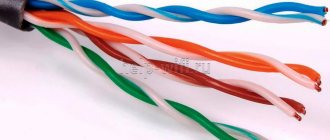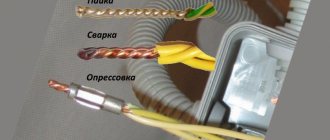Today there are many ways to connect wires. There are about a dozen types of terminal blocks alone. One of them is Scotch-lock. With its help, you can quickly cut into a line or connect a conductor without a soldering iron or expensive tools. There are a lot of disputes, myths and speculations about these products among experts; in this regard, in this article we will look at what Scotchlock is and how it can be used.
What it is
Scotchlok are clamp terminal blocks for connecting current-carrying conductors. The core is fixed by compression in a knife-type contact. The body of the Scotchlocks is dielectric and allows you to make an insulated connection.
Usually made of polypropylene or fire-resistant nylon (different sources have different information) there is a U-shaped contact inside it that cuts through the insulation and provides a connection for the wires. The hydrophobic gel that Scotchlock is filled with will protect the connections from moisture, which significantly increases the reliability and durability of the contacts.
The development belongs to the company 3M, which is also known for adhesive solutions that are used in LED strips, insulation and other products. But Scotchlocks are also made by other brands, but 3M is more common than others.
According to the principle of operation, they are similar to piercing clamps for SIP brand wires. Certain types of adhesive tape can also create a branch connection from a line without relieving the voltage and without breaking it; such a connection is often called “paralleling.”
Installation is carried out in two steps - insertion of the conductor and crimp. Depending on the size of the adhesive tape, it is possible to connect cores with a cross-section from 0.4 to 4 square meters. mm depending on the specific model.
Main types
For almost any situation, electricians will be able to choose the right option from the extensive range of modifications of Scotchlok 3M products.
The main types of connectors are T-shaped, dead-end and feed-through devices. The number of wires is usually 2 or 3.
There is an adhesive tape - a wire connector with or without a protective gel filling. Almost each of the models under consideration is available in two specified versions. An example would be the gel-filled UB2A and its 100% non-gel counterpart, UB2A-D.
Let's get acquainted with samples of the most common samples in practice.
To work with small sections:
- connector with gel for a pair of cores with cross-sectional parameters of 0.4-0.9 mm Scotchlok UY-2. The dimensions of the inlet make it possible to use a wire with an external insulation diameter of 2.08 mm;
- A convenient option for branching the line is to use the triple UR model. This method is ideal for working with three conductors with a cross-section ranging from 0.4 to 0.9 mm and an outer diameter of the insulating layer of 2.08 mm. There is also a gel filling;
- paralleling to the main line - the functional purpose of UB2A with wire parameters identical to the previous adhesive tape;
- The type of feed-through type includes the U1b model for conductive cores of 0.9-1.3 mm and insulation diameters of up to 3.18 mm.
For large sections the following are used:
- fixing wires 0.5-1.5 sq. mm using Scotchlok 316 IR connector;
- thick wires with a cross section of 2.5 square meters. mm – area of application of MGC adhesive tape;
- dead-end models 558 for working with conductor taps with a cross-section of 0.5-1.5 mm;
- If you need installation without breaking the cable, a good choice would be a Scotchlok gel-free product. The terminal block is made on the principle of a drop-down suitcase and presses the wire when closed. You can also recess the knife with pliers;
- terminal block 534 differs from the previous one only in the nominal cross-section of the TPG;
- For perpendicular insertion of the main line, the 952 T-shaped connector is suitable.
As you can see, the presented range is sufficient for most cases encountered in practice.
ScotchLock Connectors
These connectors are disposable and are designed for connecting low-current wires without stripping the insulation. Ideal for telephone cable and twisted pair cables. There are different modifications: two wires, three, with or without protective gel.
All you need from a tool is pliers. The wires that need to be connected are inserted into the connector all the way, and then this entire structure is sharply and strongly compressed with pliers. There should be a slight crunch/click and the top “plug” should sit down.
This cuts through the insulating sheath of the wire and the blade contact makes the connection inside the clamp. I use them to connect telephone cables in customer panels or for some kind of unraveling of twisted pairs (for example, how one twisted pair in a floor panel is connected to a telephone and an intercom at the same time).
Application area
Typically, this connection technology is popular among electricians when working with telephone and computer networks. This method is suitable for situations with twisted pair cables in low-current circuits.
Low-voltage automotive wiring is another application option when it is necessary to insert into the main line. The figure below shows an example of connecting a radio with a non-standard plug using adhesive tape.
But it is better to fix the power wires with other clamps - elements like WAGO and soldering are suitable here.
Related materials:
← Previous page
Next page →
Kinds
The 3M Scotchlock product line is broad enough to meet the needs of electricians in most situations. By type, connectors are distinguished:
- Passage;
- Dead-end;
- T-shaped.
By the number of wires, most often it is:
- On 2;
- For 3 wires;
There are terminal blocks with and without protective gel filling. Typically, each of the types that we will consider below can be found in these two versions. For example, UB2A connectors are filled with gel, and UB2A-D are their complete analog without gel. We have made a selection of types of Scotchlocks commonly used in practice.
For small sections:
- Scotchlock UY-2 gel-filled connector for two wires with a cross-section from 0.4 to 0.9 mm. The inlet allows the use of wire with an outer insulation diameter of 2.08 mm.
- The triple terminal block UR2 is used for branching the line. With its help, you can connect three conductors with a cross-section from 0.4 to 0.9 mm with an insulation diameter of up to 2.08 mm. Filled with gel.
- The UB2A tape lock is designed for paralleling wires to the main line with a cross-section of current-carrying conductors from 0.4 to 0.9 mm, the same as in the previous ones - the maximum insulation diameter is 2.08 mm.
- Type U1b feed-through connector for TPG 0.9-1.3 mm with insulation diameter up to 3.18 mm.
For large sections:
- Scotchlok 316 IR for wires with a cross-section of 0.5-1.5 sq. mm.
- Model MGC, connector for thick cores with a cross-section of 2.5 sq. mm.
- Scotchlok 558 – dead-end connectors are designed for connecting and tapping wires with a cross-section of 0.5-1.5 mm.
- Scotchlok 560 for branching without breaking the cable. Suitable for cores with a cross section of 0.75-1.5 mm. without gel due to design features. The terminal block opens like a suitcase and clamps the wires when closed, or the knife is pre-retracted with pliers.
- Model 534 terminal block is similar in design to the previous one, but differs in the permissible cross-section of the TPG, this time 1.5-2.5 sq.m. is allowed. mm.
- ScotchLok 952 is a T-connector, also designed for insertion perpendicular to the main line. Insertion at right angles occurs using a male terminal into the cut on the side of the connector when it is closed.
The listed types of adhesive locks should be enough for you in most practical situations, but now let’s move on to talking about how to use this type of terminal blocks.
Scope of application
More than any other electrician, Scotchlocks are the favorite method of connecting computer and telephone network installers. They are excellent for low-current circuits, for example, for twisted pair, you can use models UY-2, UR2, UB2A. In this way, you can organize branches, extensions and a number of other connections for the network cable.
They are also often used for low voltage circuits, such as automotive wiring. With their help, it is better to connect, again, for low-current circuits, for example, for inserting into the main wiring of alarm systems, central locking systems, low-power speakers, and so on. You can see an example of using adhesive tapes for car wiring below, this is how a radio with a non-standard plug is connected.
For power wires, it is better not to use this type of connector; WAGO type clamps, sleeves and other connection options, such as soldering, are better suited here.
The video clearly shows how to use Scotchlock:
How to connect wires using tape
Let's look at how a connection using Scotchlock is used. Using an adhesive tape in which a mortise contact is installed, two wires are connected to each other, with a maximum diameter of 0.4 mm. In this case, preliminary stripping of the insulation is not necessary; simply pressing the red button activates the contact plate. Under the influence of the contact plate, the insulation of the wires is cut through and they are further connected by insertion into the copper part.
In essence, this is a specially designed spring blade contact. After which, the connector cover snaps into place and the desired contact is held in the conductors. The contact points are protected by a water-repellent gel, which is placed inside the adhesive tape. Consequently, the tightness of the entire area where the contacts are located is ensured. Then diffusion occurs, which reliably connects the contact and the wire in a cold way.
This connection is used when it is necessary to make a wire branch from the main line and it is necessary to reliably insulate the connection. Designed to work with a variety of cables. There are designs of Scotchlocks that allow them to be used in conventional electrical networks. Therefore, in this case, the maximum cross-section of cables and wires is 4 mm, and taking into account insulation 5 mm. Products can operate at a nominal voltage of 600 volts, and in some cases 1000 volts.
Where are Scotchlocks suitable and where are they not?
The ideal place to use these connectors is in car electrical or speaker wires. Forget about all other methods - for low voltage, adhesive tape is the best option.
But for 220-volt wiring, Scotchlocks must be used with caution. Although the manufacturer indicates that the connectors operate up to 600 Volts, there are live spots in them that can be accidentally touched, for example, if you climb into a junction box.
Therefore, use them only if you are sure that no one except experienced electricians will go there, and even better, do not use them for dangerous voltage at all.
Features of use
As you can see, there are two types of Scotchlocks. The first ones are those that open up like a suitcase. Rarely, but on forums you can find the name “suitcase-type terminal blocks”, and another option is non-expanding, to use them you need to press on the surface of the terminal block to cut into the wires. Both adhesive locks use the same U-shaped contacts. There are no special differences in how to use it.
For non-opening terminal blocks such as UY-2, UR2 and the like, there are special crimping pliers with flat parallel jaws.
But they can be successfully replaced with pliers, and in some cases squeezed with your fingers. The opening terminal blocks are compressed along the metal contact bracket in the open state.
Scotch tapes with gel do not require additional insulation. Placed on an insulated, unstripped wire. To connect, just cut the ends evenly and insert them into the hole or insert them into the open terminal block. In turn, it is better to additionally insulate tapes without gel with electrical tape or heat-shrink tubing.
Do not exceed the recommended conductor cross-sections and do not connect conductors that are thinner than specified. In the first case, you will damage the conductive wires, and in the second, you will not ensure proper fixation in the knife. You can connect cable products with solid and stranded conductors, but do not use tape locks for aluminum wire. Due to the fluidity of aluminum, the contact will quickly weaken.
Features of application
The two main types of devices when connecting with adhesive tape are non-opening terminal blocks and modifications of the suitcase design. All of them are equipped with identical U-shaped contacts, the difference is that all non-expanding samples, including UY-2 and UR2, require a specially designed crimping pliers with parallel, flat-shaped jaws.
But using pliers is also a fairly common method. Models related to suitcases are compressed in the open position of the pores to a metal contact-bracket.
There is no need for additional insulation when filling with gel. The connection is very simple - straight cut ends are inserted into the hole and placed in the terminal block. But if there is no gel, it is recommended to use heat-shrink tubing or electrical tape.
Please ensure that the conductor cross-sections are within acceptable limits. The conductors will be damaged if the recommended parameters are exceeded and will not be able to be securely fixed at thin values.
The wide variability of connections with multi- and single-wire wires does not allow the installation of adhesive tapes for aluminum conductors. There is a rapid weakening of the contact due to the high fluidity of this metal.
Using Scotch-lock to connect twisted pair cables
For those who are still fans of twisting, there is a more modern option than simply twisting the wires together. It's called Scotchlock. You don't need any special tool to do the job - just pliers.
To connect the Internet cable to each other, we strip it of general insulation on both sides and arrange it by color. We tuck the wires color-by-color into Scotchlock tape. After they are tucked in, we put the connector cap on top and clamp it with pliers. The main thing is without fanaticism. The task here is not to crush the Scotchlok, but to ensure that the veins come into good contact with the knife. The result will be a spliced network cable.











